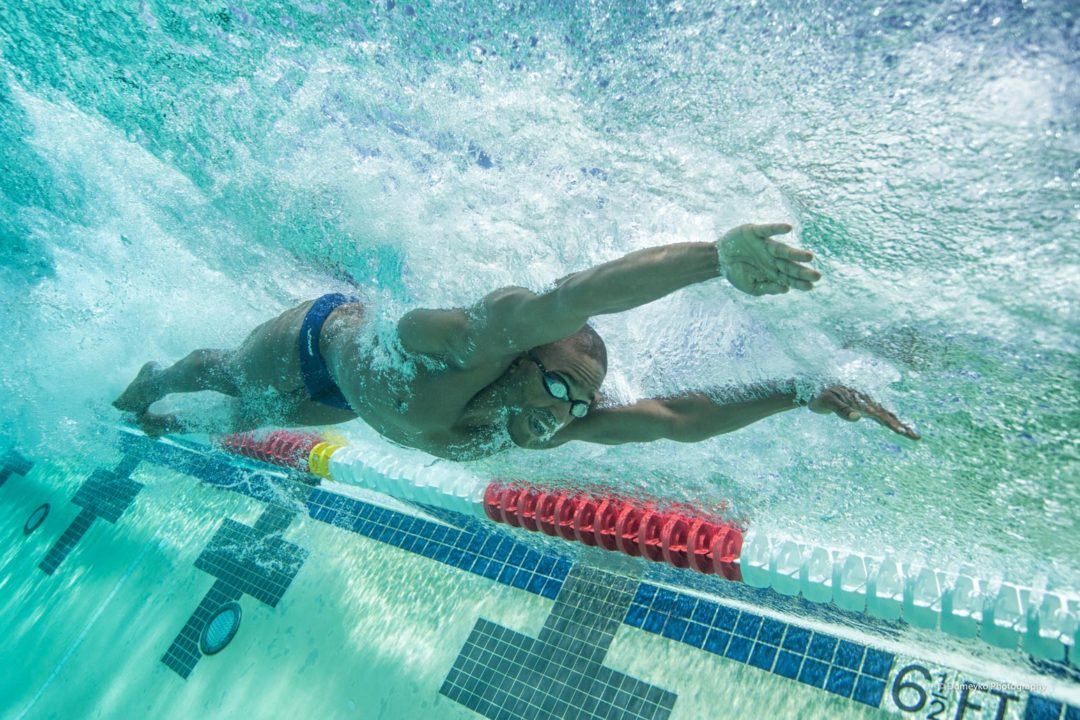Courtesy of Gary Hall Sr., 10-time World Record Holder, 3-time Olympian, 1976 Olympic Games US Flagbearer and The Race Club co-founder.
Frontal drag
Most sports take place in air, where drag forces apply but are not nearly as detrimental to performance as they are in swimming. With the density of water being 784 times greater than air, any errors we make in our body position or stroke mechanics are compounded at almost any speed, but even more so at higher speeds. However, we don’t have to be going very fast at all in water for these drag forces to ruin our day. The faster we swim, the bigger price we pay for our mistakes. Frontal drag is enemy #1 of the swimmer. There is no mercy in the water.
There are four factors that determine how much frontal drag will slow a swimmer down. The first is position. Is the swimmer underwater or on the surface? The second is the cross-sectional surface area of the swimmer moving forward. How large is the swimmer? What is the body angle? Are the legs and arms protruding out too far? Is the head too high? The third is the surface characteristic of the swimmer, including the suit, cap and goggles. How slippery is the swimmer? The fourth, and most important, is the swimmer’s speed. How fast is he or she moving in the water?
There are three different types of frontal drag forces that can slow a swimmer down, and they are all important. The first and most profound is pressure or form drag which occurs as a result of two important facts we see in good swimmers. First, swimmers are non-streamlined objects, even in the best position they can achieve. Second, good swimmers are in water and travel at speeds approximating 2 meters/second or higher. The physical shape of a swimmer (surface area moving forward), the medium of water, and the speed of the swimmer in the water are factors that determine what is called the Reynold’s number. This determines the flow characteristics around the moving swimmer. At the Reynold’s number of a good swimmer wearing a tech suit, the flow of water around him/her will change from laminar (smooth, at the head and shoulders) to transitional (separated from the boundary a foot or so behind the head and shoulders) to turbulent (somewhere near the waist). As the fluid transitions from the boundary of the swimmer’s body to a turbulent state, it then forms a vortex or slipstream behind the swimmer. The difference between the higher pressure at the head of the swimmer and the lower pressure behind the swimmer in the slipstream is what determines the pressure drag.
The second drag force is caused by friction. Friction occurs as a result of molecules rubbing against each other as an object moves through a medium; in this case, water. In general, the rougher the object (swimmer), the more friction. The smoother or slicker the object (swimmer), the less friction. Thus, the friction of a swimmer is largely determined by the surface characteristics of the swimmer; the cap, the skin, the goggles and the suit.
Third type of drag force is called surface or wave drag. It occurs as a result of the swimmer being partly in the water (submerged) and partly out of the water. Virtually all of the wave drag of a swimmer occurs from the front end of the swimmer’s body (head and shoulders).
 In a study done in 2004, Mollendorf et al determined the contribution of all three types of frontal drag forces on swimmers while being towed at various speeds in a fixed, streamlined position (passive drag forces).[1] When low friction (high tech) suits were worn, and at approximately race speed for elite swimmers, they found that pressure drag forces accounted for about 50% of the total drag force, while wave drag forces and friction each accounted for about 25% of the total drag force. The total frontal drag forces were about three times greater at 2 m/sec (race speed) than they were at 1 m/sec. When low tech suits were worn, friction was a greater contributor to total drag than pressure or wave drag.
In a study done in 2004, Mollendorf et al determined the contribution of all three types of frontal drag forces on swimmers while being towed at various speeds in a fixed, streamlined position (passive drag forces).[1] When low friction (high tech) suits were worn, and at approximately race speed for elite swimmers, they found that pressure drag forces accounted for about 50% of the total drag force, while wave drag forces and friction each accounted for about 25% of the total drag force. The total frontal drag forces were about three times greater at 2 m/sec (race speed) than they were at 1 m/sec. When low tech suits were worn, friction was a greater contributor to total drag than pressure or wave drag.
The reason that the swimmer’s speed is the most important factor in determining frontal drag is that all three types of drag forces are exponentially related to the swimmer’s speed. Both pressure drag and friction are proportional to the square of the swimmer’s speed, while wave drag is proportional to the fourth power of the swimmer’s speed. From this observation, we can conclude the following:
- All three types of frontal drag are important and need to be reduced as much as possible
- Small changes in a swimmer’s shape or position, cap and suit can have profound impacts on frontal drag at race speed
- Getting under water is desirable (eliminating wave drag) whenever possible while in a relative streamline position at race speed
- The stronger and faster a swimmer becomes, the more important technique becomes (the frontal drag forces at 2 m/sec are about three times greater than at 1 m/sec)
This week in Lanes 2, 3 and 4, you will receive the Race Club webisode featuring our favorite way to streamline in order reduce frontal drag. We hope you enjoy.
Yours in Swimming,
Gary Sr.
Like The Race Club on Facebook
Follow The Race Club on Instagram
Follow The Race Club on Twitter
Connect to The Race Club / Gary Hall Sr. on Linkedin
THE RACE CLUB
Because Life is Worth Swimming, our mission is to promote swimming through sport, lifelong enjoyment, and good health benefits. Our objective is for each member of and each participant in The Race Club to improve his or her swimming performances, health, and self-esteem through our educational programs, services and creativity. We strive to help each member of The Race Club overcome challenges and reach his or her individual life goals.
 The Race Club provides facilities, coaching, training, technical instruction, video, fitness and health programs for swimmers of all ages and abilities. Race Club swim camps are designed and tailored to satisfy each swimmer’s needs, whether one is trying to reach the Olympic Games or simply improve one’s fitness. Our programs are suitable for beginner swimmers, pleasure swimmers, fitness swimmers, USA swimming or YMCA swimmers, or triathletes; anyone who wants to improve swimming skills. All of our Race Club members share an enjoyment of being in the water and use swimming to stimulate a more active mind and body.
The Race Club provides facilities, coaching, training, technical instruction, video, fitness and health programs for swimmers of all ages and abilities. Race Club swim camps are designed and tailored to satisfy each swimmer’s needs, whether one is trying to reach the Olympic Games or simply improve one’s fitness. Our programs are suitable for beginner swimmers, pleasure swimmers, fitness swimmers, USA swimming or YMCA swimmers, or triathletes; anyone who wants to improve swimming skills. All of our Race Club members share an enjoyment of being in the water and use swimming to stimulate a more active mind and body.



So are you saying because I have a real big head, my frontal drag will make me slower than Jimmie? He has one of those teeny pea-heads.
Too bad your not a cone head.
Lol – Great comeback!!! Keep up the amazing work Gary you are the best.